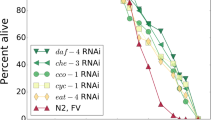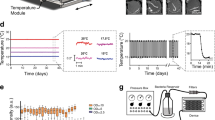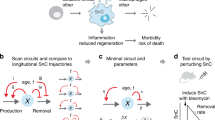Abstract
The measurement of lifespan pervades aging research. Because lifespan results from complex interactions between genetic, environmental and stochastic factors, it varies widely even among isogenic individuals. The actions of molecular mechanisms on lifespan are therefore visible only through their statistical effects on populations. Indeed, survival assays in Caenorhabditis elegans have provided critical insights into evolutionarily conserved determinants of aging. To enable the rapid acquisition of survival curves at an arbitrary statistical resolution, we developed a scalable imaging and analysis platform to observe nematodes over multiple weeks across square meters of agar surface at 8-μm resolution. The automated method generates a permanent visual record of individual deaths from which survival curves are constructed and validated, producing data consistent with results from the manual method of survival curve acquisition for several mutants in both standard and stressful environments. Our approach permits rapid, detailed reverse-genetic and chemical screens for effects on survival and enables quantitative investigations into the statistical structure of aging.
This is a preview of subscription content, access via your institution
Access options
Subscribe to this journal
Receive 12 print issues and online access
$259.00 per year
only $21.58 per issue
Buy this article
- Purchase on Springer Link
- Instant access to full article PDF
Prices may be subject to local taxes which are calculated during checkout




Similar content being viewed by others
References
Kirkwood, T.B. et al. What accounts for the wide variation in life span of genetically identical organisms reared in a constant environment? Mech. Ageing Dev. 126, 439–443 (2005).
Friedman, D.B. & Johnson, T.E. A mutation in the age-1 gene in Caenorhabditis elegans lengthens life and reduces hermaphrodite fertility. Genetics 118, 75–86 (1988).
Kenyon, C., Chang, J., Gensch, E., Rudner, A. & Tabtiang, R. A C. elegans mutant that lives twice as long as wild type. Nature 366, 461–464 (1993).
Kimura, K.D., Tissenbaum, H.A., Liu, Y. & Ruvkun, G. daf-2, an insulin receptor-like gene that regulates longevity and diapause in Caenorhabditis elegans. Science 277, 942–946 (1997).
Kenyon, C.J. The genetics of ageing. Nature 464, 504–512 (2010).
Sutphin, G.L. & Kaeberlein, M. Measuring Caenorhabditis elegans life span on solid media. J. Vis. Exp. 12, pii: 1152 (2009).
Wilkinson, D.S., Taylor, R.C. & Dillin, A. Analysis of aging in Caenorhabditis elegans. Methods Cell Biol. 107, 353–381 (2012).
Curtsinger, J.W., Fukui, H.H., Townsend, D.R. & Vaupel, J.W. Demography of genotypes: failure of the limited life-span paradigm in Drosophila melanogaster. Science 258, 461–463 (1992).
Carey, J.R., Liedo, P. & Vaupel, J.W. Mortality dynamics of density in the Mediterranean fruit fly. Exp. Gerontol. 30, 605–629 (1995).
Vaupel, J.W. et al. Biodemographic trajectories of longevity. Science 280, 855–860 (1998).
Vanfleteren, J.R., De Vreese, A. & Braeckman, B.P. Two-parameter logistic and Weibull equations provide better fits to survival data from isogenic populations of Caenorhabditis elegans in axenic culture than does the Gompertz model. J. Gerontol. A Biol. Sci. Med. Sci. 53, B393–B408 (1998).
Johnson, T.E., Wu, D., Tedesco, P., Dames, S. & Vaupel, J.W. Age-specific demographic profiles of longevity mutants in Caenorhabditis elegans show segmental effects. J. Gerontol. A Biol. Sci. Med. Sci. 56, B331–B339 (2001).
Mair, W., Goymer, P., Pletcher, S.D. & Partridge, L. Demography of dietary restriction and death in Drosophila. Science 301, 1731–1733 (2003).
Baeriswyl, S. et al. Modulation of aging profiles in isogenic populations of Caenorhabditis elegans by bacteria causing different extrinsic mortality rates. Biogerontology 11, 53–65 (2010).
Wu, D., Rea, S.L., Cypser, J.R. & Johnson, T.E. Mortality shifts in Caenorhabditis elegans: remembrance of conditions past. Aging Cell 8, 666–675 (2009).
Lithgow, G.J., White, T.M., Melov, S. & Johnson, T.E. Thermotolerance and extended life-span conferred by single-gene mutations and induced by thermal stress. Proc. Natl. Acad. Sci. USA 92, 7540–7544 (1995).
Klass, M.R. Aging in the nematode Caenorhabditis elegans: major biological and environmental factors influencing life span. Mech. Ageing Dev. 6, 413–429 (1977).
Herndon, L.A. et al. Stochastic and genetic factors influence tissue-specific decline in ageing C. elegans. Nature 419, 808–814 (2002).
Huang, C., Xiong, C. & Kornfeld, K. Measurements of age-related changes of physiological processes that predict lifespan of Caenorhabditis elegans. Proc. Natl. Acad. Sci. USA 101, 8084–8089 (2004).
Müller, H.G. & Wang, J.L. Hazard rate estimation under random censoring with varying kernels and bandwidths. Biometrics 50, 61–76 (1994).
Vaupel, J.W., Manton, K.G. & Stallard, E. The impact of heterogeneity in individual frailty on the dynamics of mortality. Demography 16, 439–454 (1979).
Weitz, J.S. & Fraser, H.B. Explaining mortality rate plateaus. Proc. Natl. Acad. Sci. USA 98, 15383–15386 (2001).
Mathew, M.D., Mathew, N.D. & Ebert, P.R. WormScan: a technique for high-throughput phenotypic analysis of Caenorhabditis elegans. PLoS ONE 7, e33483 (2012).
Dillin, A., Crawford, D.K. & Kenyon, C. Timing requirements for insulin/IGF-1 signaling in C. elegans. Science 298, 830–834 (2002).
Larsen, P.L., Albert, P.S. & Riddle, D.L. Genes that regulate both development and longevity in Caenorhabditis elegans. Genetics 139, 1567–1583 (1995).
Ailion, M., Inoue, T., Weaver, C.I., Holdcraft, R.W. & Thomas, J.H. Neurosecretory control of aging in Caenorhabditis elegans. Proc. Natl. Acad. Sci. USA 96, 7394–7397 (1999).
Haskins, K.A., Russell, J.F., Gaddis, N., Dressman, H.K. & Aballay, A. Unfolded protein response genes regulated by CED-1 are required for Caenorhabditis elegans innate immunity. Dev. Cell 15, 87–97 (2008).
Tullet, J.M. et al. Direct inhibition of the longevity-promoting factor SKN-1 by insulin-like signaling in C. elegans. Cell 132, 1025–1038 (2008).
Kiontke, K.C. et al. A phylogeny and molecular barcodes for Caenorhabditis, with numerous new species from rotting fruits. BMC Evol. Biol. 11, 339 (2011).
Amrit, F.R., Boehnisch, C.M. & May, R.C. Phenotypic covariance of longevity, immunity and stress resistance in the Caenorhabditis nematodes. PLoS ONE 5, e9978 (2010).
Stiernagle, T. Maintenance of C. elegans. in WormBook http://dx.doi.org/10.1895/wormbook.1.101.1 (2006).
Dong, J.X., Krzyzak, A. & Suen, C.Y. Fast SVM training algorithm with decomposition on very large data sets. IEEE Trans. Pattern Anal. Mach. Intell. 27, 603–618 (2005).
Sall, J., Lehman, A., Stephens, M. & Creighton, L. JMP Start Statistics: A Guide to Statistics and Data Analysis using JMP 5th edn. (SAS Institute, Cary, North Carolina, 2012).
R Development Core Team. R: A Language and Environment for Statistical Computing (R Foundation for Statistical Computing, Vienna, 2006).
Buckley, J. & James, I. Linear regression with censored data. Biometrika 66, 429–436 (1979).
Acknowledgements
We thank J. Alcedo (Wayne State University) for providing the hsf-1 and glp-1 mutant strains, X. Manière (Université Paris Descartes) for providing the NEC937 strain, B. Ward and D. Marks for critical reading of our manuscript and C. Romero, D. Marks and the members of the Fontana lab for helpful discussions and encouragement throughout this project. We thank T. Kolokotrones, E. Smith and L.J. Wei for discussions and statistical advice and M. Miranda, our departmental IT specialist, for patiently meeting our needs for data storage. Some nematode strains used in this work were provided by the Caenorhabditis Genetics Center, which is funded by the National Center for Research Resources. This work was funded by the US National Institutes of Health through grants R03 AG032481, R03 AG032481-S1 and R01 AG034994.
Author information
Authors and Affiliations
Contributions
N.S. designed and implemented hardware and software. N.S. and B.E.U. constructed and calibrated equipment. N.S. and J.A. conceived and designed experiments. N.S., B.E.U., J.A., Z.M.N. and I.F.L.-M. performed experiments. N.S. designed analytic tools. N.S., J.A. and W.F. provided guidance, analyzed data, interpreted results and wrote the manuscript. J.A and W.F. are co-last authors.
Corresponding authors
Ethics declarations
Competing interests
The authors declare no competing financial interests.
Supplementary information
Supplementary Text and Figures
Supplementary Notes 1–16 (PDF 6347 kb)
Supplementary Data
Directory containing all lifespan data referenced in the manuscript (ZIP 277 kb)
Supplementary Table 1
Population sizes and statistical survival data (XLS 82 kb)
Raw time lapse of a single plate with wild-type animals
A time-lapse video covering 3 weeks of automatic image captures by the Lifespan Machine of a single plate with wild-type animals. (MOV 1293 kb)
Annotated time lapse of a single plate with wild-type animals
A time-lapse video covering 3 weeks of automatic image captures by the Lifespan Machine of a single plate with wild-type animals (Supplementary Video 1), overlaid with metadata from image analysis. Animals are colored according to their movement class. Animals that manifest locomotion are colored purple. Stationary animals that manifest posture changes are colored yellow. Completely motionless (dead) animals are colored red. Blue objects have been excluded as nonworm objects during the validation step. The survival curve of the plate population is shown in yellow, and the aggregated survival curve for the population across all plates on the entire scanner is shown in red. (MOV 1377 kb)
Raw time lapse of a single plate with age-1(hx546) mutants
A time-lapse video covering 3 weeks of automatic image captures by the Lifespan Machine of a single plate with age-1(hx546) mutants. (MOV 1812 kb)
Annotated time lapse of a single plate with age-1(hx546) mutants
A time-lapse video covering 3 weeks of automatic image captures by the Lifespan Machine of a single plate with age-1(hx546) mutants, overlaid with metadata from image analysis. The coloring is as described in Supplementary Video 2. (MOV 2346 kb)
Annotated time lapse of a single plate with unc-64(e246) mutants
A time-lapse video covering 3 weeks of automatic image captures by the Lifespan Machine of a single plate with unc-64(e246) mutants, overlaid with metadata from image analysis. The coloring is as described in Supplementary Video 2. (MOV 935 kb)
Worm Browser demo
00:03 The Worm Browser is a desktop utility that allows users to interact with Lifespan Machine data. 00:08 Data from different experiments can be easily accessed. 00:21 Worm deaths can be inspected in a variety of ways. For example, all animals observed in an experiment can be sorted by their death time, or a single plate can be observed in isolation. Individuals can be viewed at their time of death or at the time of death of the last animal to die in the experiment. 00:26 Objects that have been incorrectly classified as worms can be flagged for exclusion. 00:33 The death transition of a worm can be inspected by clicking through a time-lapse video of late-life movements. The first (upper) colored bar underneath the image of the worm represents the time during which the animal is detected as having ceased locomotion. The switch from yellow to red marks the worm's transition from changing posture to being completely motionless and is taken as the time of death. 00:33 The second (lower) colored bar is used for human annotation of the animal's death time. These data are stored and later used to generate various diagnostics. 01:10 In a number of cases, several worms may die closely juxtaposed. These cases can be annotated and taken into account when the survival curves are assembled. 01:27 The Worm Brower generates a variety of statistical outputs, including survival curves, quantification of worm movement and comparisons between automated and manual annotations. (AVI 15642 kb)
Rights and permissions
About this article
Cite this article
Stroustrup, N., Ulmschneider, B., Nash, Z. et al. The Caenorhabditis elegans Lifespan Machine. Nat Methods 10, 665–670 (2013). https://doi.org/10.1038/nmeth.2475
Received:
Accepted:
Published:
Issue Date:
DOI: https://doi.org/10.1038/nmeth.2475
This article is cited by
-
Caenorhabditis elegans foraging patterns follow a simple rule of thumb
Communications Biology (2023)
-
The million-molecule challenge: a moonshot project to rapidly advance longevity intervention discovery
GeroScience (2023)
-
Adult-restricted gene knock-down reveals candidates that affect locomotive healthspan in C. elegans
Biogerontology (2023)
-
Rapid measurement of ageing by automated monitoring of movement of C. elegans populations
GeroScience (2023)
-
Ageing-associated changes in transcriptional elongation influence longevity
Nature (2023)



